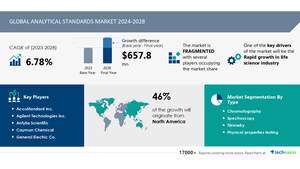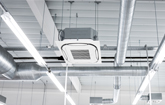NEW YORK, Oct. 17, 2024 /PRNewswire/ -- Report on how AI is driving market transformation - The Global Commercial Air Conditioner Market size is estimated to grow by USD 46.28 billion from 2024-2028, according to Technavio. The market is estimated to grow at a CAGR of over 6.3% during the forecast period. Increasing demand for energy-efficient commercial air conditioners is driving market growth, with a trend towards increase in use of R32 refrigerant in split air conditioners. However, high initial costs associated with commercial air conditioners poses a challenge - Key market players include AAON Inc., Blue Star Ltd., Carrier Global Corp., Daikin Industries Ltd., Danfoss AS, Emerson Electric Co., Fujitsu Ltd., Haier Smart Home Co. Ltd., Hitachi Ltd., Honeywell International Inc., Johnson Controls International Plc., Lennox International Inc., LG Electronics Inc., Mitsubishi Electric Corp., Modine Manufacturing Co., Panasonic Holdings Corp., Samsung Electronics Co. Ltd., Toshiba Corp., Trane Technologies Plc, and Voltas Ltd..
AI-Powered Market Evolution Insights. Our comprehensive market report ready with the latest trends, growth opportunities, and strategic analysis- View your snapshot now
Forecast period |
2024-2028 |
Base Year |
2023 |
Historic Data |
2018 - 2022 |
Segment Covered |
Product (Split systems, VRF systems, Chillers, Rooftops, and Others), Technology (Non-inverter and Inverter), and Geography (North America, APAC, Middle East and Africa, Europe, and South America) |
Region Covered |
North America, APAC, Middle East and Africa, Europe, and South America |
Key companies profiled |
AAON Inc., Blue Star Ltd., Carrier Global Corp., Daikin Industries Ltd., Danfoss AS, Emerson Electric Co., Fujitsu Ltd., Haier Smart Home Co. Ltd., Hitachi Ltd., Honeywell International Inc., Johnson Controls International Plc., Lennox International Inc., LG Electronics Inc., Mitsubishi Electric Corp., Modine Manufacturing Co., Panasonic Holdings Corp., Samsung Electronics Co. Ltd., Toshiba Corp., Trane Technologies Plc, and Voltas Ltd. |
Key Market Trends Fueling Growth
Commercial air conditioners utilize refrigerants, which are compounds capable of absorbing heat from the environment, in conjunction with components like compressors and evaporators to provide cooling. Vendors often employ various refrigerants, such as R-410A, due to their zero-ozone depletion potential and low global warming potential. However, R-410A consumes more energy, leading vendors to explore alternatives like R32 refrigerant. R32 refrigerant, used by Daikin Industries Ltd. In commercial air conditioners, reduces electricity consumption by up to 10%, has a three-times lower global warming potential, and boasts a lower environmental impact. This eco-friendly refrigerant contributes to reduced carbon emissions and improved cooling efficiency, making it an attractive option for commercial air conditioner manufacturers. As a result, the increasing availability of split commercial air conditioners using R32 refrigerant is anticipated to boost market growth during the forecast period.
The Commercial Air Conditioner market is thriving due to the increasing construction activities in business spaces, including offices, co-working spaces, and IT sectors. Tier 2 cities are witnessing in new buildings, providing ample opportunities for growth. In metropolitan cities, the demand for sustainable cooling strategies is on the rise due to extreme climatic conditions and pollution levels. Refrigerants with lower global warming potential are gaining popularity to reduce energy bills and promote sustainability. Investment opportunities exist in various sectors like education centres, transportation facilities, and healthcare spaces. The hospitality industry, including hotels, restaurants, cafes, theatres, and sport facilities, also contributes significantly to the market. Smart technologies such as sensors, metros, and energy efficiency are driving innovation in air conditioning systems. Additionally, the use of recyclable components and alternative energy sources like solar electricity is becoming increasingly important for businesses seeking to reduce their carbon footprint.
Insights on how AI is driving innovation, efficiency, and market growth- Request Sample!
Market Challenges
- Commercial air conditioners for businesses involve larger upfront investments than residential units due to their size and complexity. These systems require larger compressors, extensive ductwork, and larger condenser units, leading to higher component and setup costs. Installation expenses, including specialized labor and electrical connections, further add to the initial investment. Additionally, commercial air conditioners consume more energy, resulting in increased operational costs. These factors may challenge the growth of the global commercial air conditioner market.
- The commercial air conditioner market faces challenges due to the phase-out of high-GWP refrigerants like hydrochlorofluorocarbons (HCFCs) and chlorofluorocarbons (CFCs). R-22 and R32 refrigerants are common replacements, but ozone depletion remains a concern. Packaged air conditioners and split units, including Room ACs and Split Units, are popular cooling solutions. End-users in the retail, hospitality, and construction sectors seek energy-efficient systems like variable refrigerant flow (VRF) and chillers. Smart cities and infrastructure projects, including metro rail systems and airports, also require eco-friendly electrical appliances. New installation and retrofit projects in offices, buildings, supermarkets/hypermarkets, and transportation contribute to market growth. Commercial cooling systems must meet energy efficiency standards and accommodate tourist activities in various commercial settings.
Insights into how AI is reshaping industries and driving growth- Download a Sample Report
This commercial air conditioner market report extensively covers market segmentation by
- Product
- 1.1 Split systems
- 1.2 VRF systems
- 1.3 Chillers
- 1.4 Rooftops
- 1.5 Others
- Technology
- 2.1 Non-inverter
- 2.2 Inverter
- Geography
- 3.1 North America
- 3.2 APAC
- 3.3 Middle East and Africa
- 3.4 Europe
- 3.5 South America
1.1 Split systems- Split air conditioners are widely used in commercial settings, such as offices, retail spaces, hotels, and healthcare facilities. These systems consist of an indoor unit and an outdoor unit. Indoor units, installed inside commercial spaces, include cooling coils, fans, and air filters. Outdoor units, placed outside buildings, house components like compressors, condenser coils, and expansion valves. The split air conditioning market's growth is driven by the demand for energy-efficient and cost-effective systems. Split air conditioners offer energy savings and various features. Easy installation and maintenance add to their popularity. Market leaders like Samsung focus on technology advancements, product innovation, and customization to cater to diverse commercial customer needs, fueling the growth of the split systems segment in the global commercial air conditioner market.
Download complimentary Sample Report to gain insights into AI's impact on market dynamics, emerging trends, and future opportunities- including forecast (2024-2028) and historic data (2018 - 2022)
The commercial air conditioner market is witnessing significant growth due to the increasing construction activities in commercial settings such as business spaces, co-working spaces, office buildings, multifamily projects, warehouse projects, and commercial buildings. In sectors like IT, healthcare, hospitality, and data centers, the demand for efficient and reliable cooling systems is on the rise. The market is also being driven by the trend towards green buildings and smart cities, which prioritize energy-efficient and eco-friendly solutions. In Tier 2 cities, the market is growing due to the influx of infrastructure projects and tourist activities. The market offers various products such as packaged air conditioners, chillers, and commercial cooling systems, with a shift towards low-GWP refrigerants like R32 and away from high-GWP refrigerants like hydrochlorofluorocarbons and chlorofluorocarbons.
The commercial air conditioner market is experiencing significant growth due to the increasing construction activities in various sectors such as commercial construction, business spaces, co-working spaces, IT sector, and educational institutions in metropolitan cities and tier 2 cities. New buildings, office spaces, multifamily projects, warehouse projects, transportation facilities, and various other commercial settings are driving the demand for air conditioners. Extreme climatic conditions and rising pollution levels are also contributing factors. Sustainable cooling strategies are gaining popularity to reduce energy bills and minimize the carbon footprint. Refrigerants with low global warming potential (GWP) such as R32 and R-22 are increasingly being used. The investment opportunity in the commercial air conditioner market is immense due to the rising employment and corporate activities. Smart technologies, sensors, and alternative energy sources like solar electricity are being integrated into commercial cooling systems to enhance energy efficiency and sustainability. Recyclable components and hydrochlorofluorocarbons (HCFCs) and chlorofluorocarbons (CFCs) phase-out are also key trends. The market includes various end-user segments such as retail, hospitality, and logistics, among others. Infrastructure projects, tourist activities, and smart cities are also significant contributors to the market growth.
1 Executive Summary
2 Market Landscape
3 Market Sizing
4 Historic Market Size
5 Five Forces Analysis
6 Market Segmentation
- Product
- Split Systems
- VRF Systems
- Chillers
- Rooftops
- Others
- Technology
- Non-inverter
- Inverter
- Geography
- North America
- APAC
- Middle East And Africa
- Europe
- South America
7 Customer Landscape
8 Geographic Landscape
9 Drivers, Challenges, and Trends
10 Company Landscape
11 Company Analysis
12 Appendix
Technavio is a leading global technology research and advisory company. Their research and analysis focuses on emerging market trends and provides actionable insights to help businesses identify market opportunities and develop effective strategies to optimize their market positions.
With over 500 specialized analysts, Technavio's report library consists of more than 17,000 reports and counting, covering 800 technologies, spanning across 50 countries. Their client base consists of enterprises of all sizes, including more than 100 Fortune 500 companies. This growing client base relies on Technavio's comprehensive coverage, extensive research, and actionable market insights to identify opportunities in existing and potential markets and assess their competitive positions within changing market scenarios.
Technavio Research
Jesse Maida
Media & Marketing Executive
US: +1 844 364 1100
UK: +44 203 893 3200
Email: [email protected]
Website: www.technavio.com/
SOURCE Technavio

WANT YOUR COMPANY'S NEWS FEATURED ON PRNEWSWIRE.COM?
Newsrooms &
Influencers
Digital Media
Outlets
Journalists
Opted In




Share this article